vices in a most praiseworthy manner. Indeed, I was much struck with the great advance made by the native inhabitants of Holsteinborg in Christian and general educational knowledge. Their school is well attended, and reading and writing are carried on admirably.
Very few persons here at home have any true conception of the great advance made in education by these Greenland Esquimaux. It has often astonished me when listening to the apt and ready way in which even children would pronounce some of their extraordinarily long words, some of those words consisting of no less than fifty letters!
The following is one of their long words, but not the longest:—
Piniagagssakardluarungnaerângat.
In all the trials made on one occasion in the cabin, by both male and female—by old and young—by all, I found none but could read, and read well.
I was surprised to see the rapidity—the full, clear enunciation of every syllable, with which they read; and one little Esquimaux boy seemed to exceed the rest, though all did well.
Perhaps I cannot give my readers a better idea of this than reprinting a small portion of a child's First Primer, beginning at the alphabet, and giving the sound of each letter. The explanation was carefully made to me by Miss Bülou.
The Greenland Esquimaux alphabet consists of twenty-four letters, as follows:—
A, B, D, E, F, G, H, I, J, K, Κʻ, L, M, N, O, P, R, S, T, U, V, Y, Æ, O.
The sound of each letter only varies from what we give to the same in the following:—
G is ke; H, ho; I, e; J, yoge; K, qu; Κʻ, qu; R, er; U, oo; Y, oe-i.
The following is the Lord's Prayer in Esquimaux:—
"Atâtarput kʻillangmêtottina! Akʻkit usfornarfille! Nâlægâvêt tikkiudle! Pekkosfæt kʻillangmifut nunnamisãak ta-

